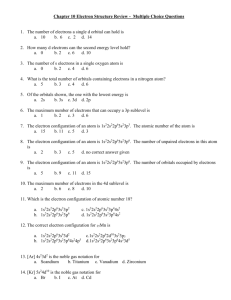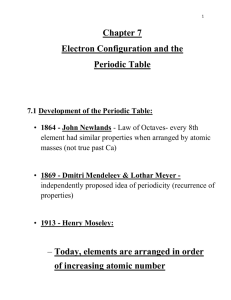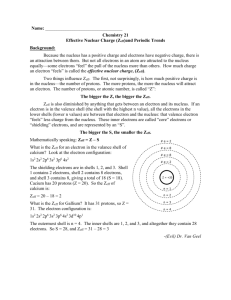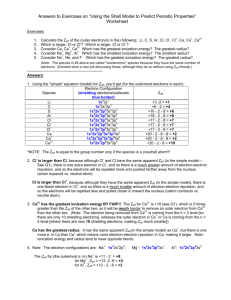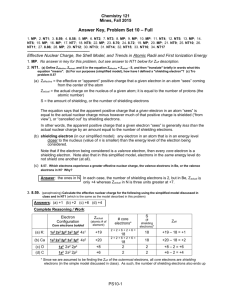Worksheet 9 Notes - Oregon State University
advertisement
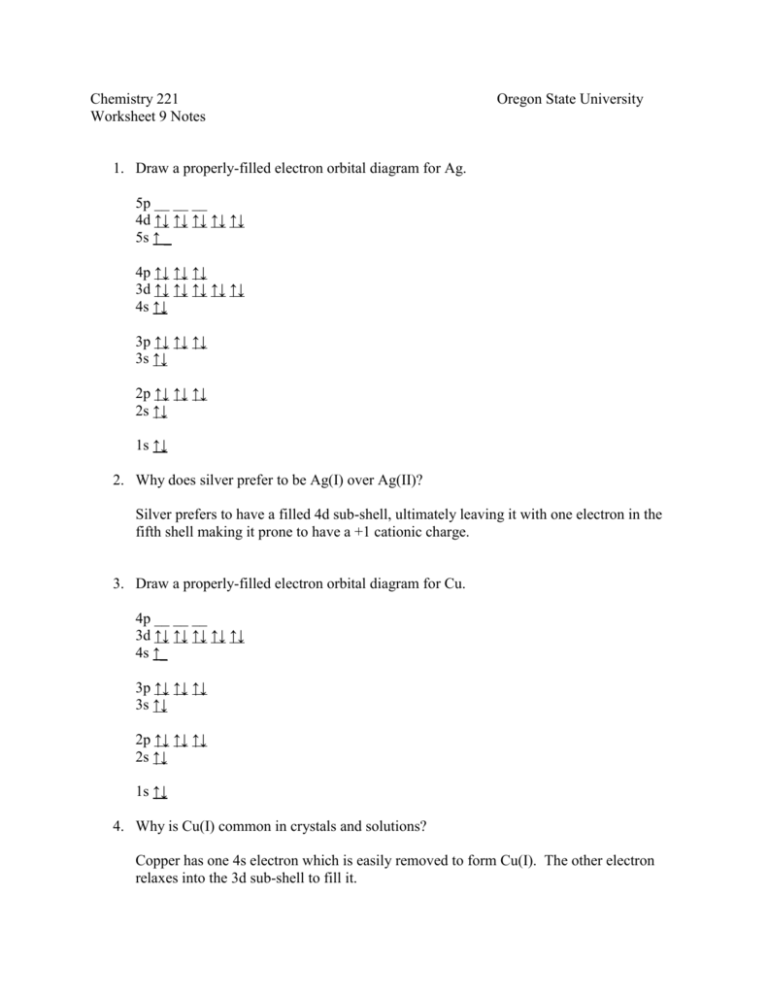
Chemistry 221 Worksheet 9 Notes Oregon State University 1. Draw a properly-filled electron orbital diagram for Ag. 5p __ __ __ 4d ↑↓ ↑↓ ↑↓ ↑↓ ↑↓ 5s ↑ _ 4p ↑↓ ↑↓ ↑↓ 3d ↑↓ ↑↓ ↑↓ ↑↓ ↑↓ 4s ↑↓ 3p ↑↓ ↑↓ ↑↓ 3s ↑↓ 2p ↑↓ ↑↓ ↑↓ 2s ↑↓ 1s ↑↓ 2. Why does silver prefer to be Ag(I) over Ag(II)? Silver prefers to have a filled 4d sub-shell, ultimately leaving it with one electron in the fifth shell making it prone to have a +1 cationic charge. 3. Draw a properly-filled electron orbital diagram for Cu. 4p __ __ __ 3d ↑↓ ↑↓ ↑↓ ↑↓ ↑↓ 4s ↑_ 3p ↑↓ ↑↓ ↑↓ 3s ↑↓ 2p ↑↓ ↑↓ ↑↓ 2s ↑↓ 1s ↑↓ 4. Why is Cu(I) common in crystals and solutions? Copper has one 4s electron which is easily removed to form Cu(I). The other electron relaxes into the 3d sub-shell to fill it. 5. Write electron configurations for the following elements and ions: a. Si - 1s22s22p63s23p2 b. Ti (IV) - 1s22s22p63s23p6 c. Hf(IV) - 1s22s22p63s23p64s23d104p65s24d105p64f14 d. P5+ - 1s22s22p63s23p6 e. Sb3- - 1s22s22p63s23p64s23d104p65s24d105p6 f. In3+ - 1s22s22p63s23p64s23d104p64d10 g. Fe (III) - 1s22s22p63s23p63d5 h. Nd - 1s22s22p63s23p64s23d104p65s24d105p66s24f4 6. Arrange the following elements and ions into isoelectronic groups and write the electron configuration of each group: Si4+, B5-, Cl-, Li+, F-, Al3+, V(V), S2-, Be2+, Ne, O2-, Ar, F-, He, Ca2+, Na+, HGroup 1: Si4+, B5-, Al3+, Ne, O2-, F-, Na+; 1s22s22p6 Group 2: Cl-, S2-, V(V), Ar, Ca2+; 1s22s22p63s23p6 Group 3: H-, Be2+, Li+, He; 1s2 7. Calculate the De Broglie wavelength of various objects at various velocities using the equation: Object baseball electron Yorkshire Terrier Chris Knutson Proton mass (kg) 0.145 9.11∙10-31 3.84 91.4 1.67∙10-27 v (m/s) 30 1000 10 3 100 λ (m) 1.52∙10 -34 7.27∙10 -7 1.73∙10-35 2.42∙10-36 3.97∙10 -9 8. Why are the de Broglie wavelengths of large objects so small? Large objects carry much more momentum than small objects, ultimately corresponding to more energy and shorter wavelengths. 9. What is shielding and how does it affect chemical reactivity for metals and non-metals? Shielding is the effective screening of nuclear charge or cancellation of nuclear charge felt by valence electrons due to the fact that there are core electrons between the nucleus and the valence electrons. 10. Calculate the effective nuclear charge (Zeff) felt by valence electrons in each of the following atoms given that : Zeff = (Nuclear charge – number of core electrons) a. b. c. d. e. f. Al - +3 Sr - +2 Br - +7 S - +6 O - +6 Ge - +4 11. How is the trend in Zeff reflected in the electronegativity of atomic species? The most electronegative atoms have the most positive Zeff distributed about the smallest volume, making them prime candidates to attract electrons. 12. Arrange the following groups of atoms in order of growing size: a. Li, Na, Rb, Fr – exactly as ordered b. S, Te, O, Po – O, S, Po, Te – this is due to the lanthanide contraction c. Na, Mg, P, S – S, P, Mg, Na d. Li, B,O , F – F, O, B, Li 13. What happens to the size of an atom when it becomes a cation? What about an anion? Why is this trend observed? Generally when an atom loses an electron it will shrink in size and when an atom gains an electron it will grow. When an atom loses an electrons, those electrons generally make up the valence shell. The subshell, with a smaller radius than the valence shell, is left making the cation smaller than the neutral atom. When an atom gains electrons, becoming an anion, the extra electrons exert more coulombic repulsion on the other valence electrons making the ion larger than the neutral atom.







